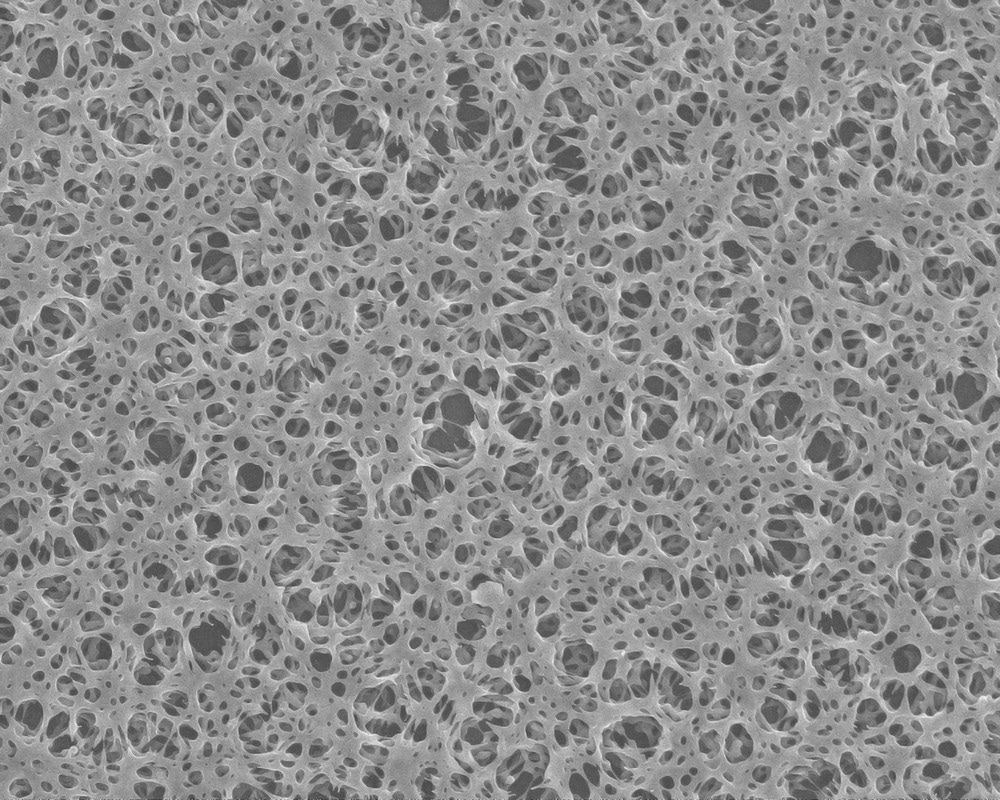Microwave ovens are a staple of modern kitchens, using microwave radiation to heat food quickly from the inside out. However, this domestic appliance can also be used to synthesize various porous materials, including advanced nanoporous materials, for a fraction of the price of conventional manufacturing methods.

Image Credit: DooDee Studio/Shutterstock.com
You Can Make Advanced Nanoporous Materials at Home
Nanoporous materials are common in nature, but it is also possible to manufacture them with synthetic methods. Commonly, different polymers with different melting points are combined to produce nanoporous materials. When the combination polymer material is warmed up, only one polymer in the mixture degrades.
Conventional electric heating has typically done the job of heating the plastic combination to make a nanoporous material. However, this consumes more energy than is required for the process and takes up more time for people and machines.
A much cheaper and simpler alternative does exist. Regular domestic microwave ovens are a simple and cheap technology that can synthesize advanced nanoporous materials quickly and efficiently.
Recent developments in microwave synthesis for nanoporous materials have led to the creation of silicas, carbons, metal-organic frameworks, and metal oxides. The materials have high specific surface areas (SSAs).
SSA is a measurement of solids that can be defined as the total surface area of the material per unit of mass or as solid or bulk volume. It is a physical property that determines the features of the material, with particular importance for adsorption, heterogeneous catalysis, and surface reactions.
Microwave synthesis produces nanoporous activated carbon frameworks with SSA ≈3100 m2 g−1, metal-organic frameworks with SSA ≈4200 m2 g−1, covalent organic frameworks with SSA ≈2900 m2 g−1, and metal oxides with relatively small SSA ≈300 m2 g−1.
Methods utilizing regular microwaves are also suitable for preparing ordered mesoporous silicas and carbons and spherically shaped nanomaterials as well. The materials can be applied in gas adsorption, water treatment, catalysis, energy storage, and drug delivery applications, among others.
Properties of Nanoporous Materials
Nanoporous materials include either a regular or inorganic bulk phase; this is where the porous structure is. To be classed as nanoporous, materials must have pore diameters measuring between 0.1 nm and 100 nm, although pores may be open or closed.
The majority of known nanoporous materials can be classified as bulk materials or membranes. Here, bulk nanoporous materials include activated carbon and zeolites, while biological cell membranes are examples of nanoporous membranes.
Their small pore sizes make them capable of discriminating between molecules and ions based on their sizes and shapes. If a nanoporous material’s pores are of a consistent size, then the material can work to filter particular substances out of samples.
Nanoporous materials’ physical and chemical properties are unique. They have good thermal stability, chemical resistance, hardness, a large SSA, and strong electron transfer, conductance, and impedance.
These materials also feature strong electromagnetic signals due to the reaction between surface and analyte.
The confined space between parts of a nanoporous materials’ surface enhances chemical reactions along it. The chemistry of the pores can be fine-tuned in synthesis to make them bind with specific biomolecules, providing a high binding selectivity of biomolecules like DNA, lipid, proteins, and enzymes to nanoporous surfaces.
Saving the world with Leerdammer cheese: Nanoporous materials to the rescue
Video Credit: Royal Society of Chemistry/YouTube.com
Applications for Nanoporous Materials
Nanoporous materials are highly sought after in the advanced manufacturing industry. They have a wide variety of applications, including filtration, extraction, separation, and catalysis.
Sensors often make use of nanoporous materials due to their unique pore structure, large SSA, and high electrical conductivity. Electrochemical sensors for detecting glucose oxidase, cholesterol, DNA, immunoglobulin, H2O2, Escherichia coli, and NO2 have all been developed using nanoporous materials.
Nanoporous membrane materials often act as a semipermeable membrane or compartment in implantable devices in biomedicine. For instance, synthetic nanoporous membranes have been used to repair patients’ kidneys, replicating the natural tissue's blood filtering and protein retention functions.
In biomolecular science, nanoporous materials are used to diagnose and separate proteins, purifying and isolating molecules from the biological feed stream.
Applications within pharmaceutical manufacturing, biotechnology, and the food industry are also typical.
In food safety, these materials can be used to detect pathogenic microorganisms like Salmonella enteritidis, bacteriophage virus MS2, E-coli, Staphylococcus aureus, and other organic molecules like food allergens.
Nanoporous gold (NPG) is a good conductor and has a desirable pore size distribution and SSA to enhance the enzymatic substrates' electrochemical response due to their low coordinated gold (Au) atoms. These advantages make NPG a decent candidate for dehydrogenase- and oxidase-based biosensors with good sensitivity and anti-interference ability.
Nanoporous Materials Will See More Applications in the Future
Due to the high costs of conventional advanced manufacturing techniques for nanoporous materials, their application has been limited to high-end sectors such as pharmaceuticals, medicine, and food safety regulation.
With advances in cheap, at-home synthesis techniques like the regular microwave oven, nanomaterials may find a much broader application rate in the coming years.
Continue reading: What are Nanoporous Materials?.
References and Further Reading
McNaught, A. and Wilkinson, A., 1(997) Compendium of chemical terminology: IUPAC recommendations. Oxford: Blackwell
Głowniak, S., B. Szczęśniak, J. Choma, and M. Jaroniec (2021) Advances in Microwave Synthesis of Nanoporous Materials. Advanced Materials. Available at: https://doi.org/10.1002/adma.202103477
Science Direct (2021) Nanoporous Material. Available at: https://www.sciencedirect.com/topics/materials-science/nanoporous-material
Nasrollahzadeh, M., Issaabadi, Z., Sajjadi, M., Sajadi, S. and Atarod, M., (2019) Types of Nanostructures. Interface Science and Technology, pp.29-80. Available at: https://doi.org/10.1016/B978-0-12-813586-0.00002-X
Mishra. M.P. et al. (2020) Potential Application of Nanoporous Materials in Biomedical Field. InTechOpen. Available at: https://doi.org/10.5772/intechopen.95928
Disclaimer: The views expressed here are those of the author expressed in their private capacity and do not necessarily represent the views of AZoM.com Limited T/A AZoNetwork the owner and operator of this website. This disclaimer forms part of the Terms and conditions of use of this website.